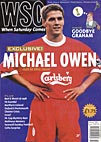 Steve Field remembers the awesomely ramshackle South Bank at Molineux
Steve Field remembers the awesomely ramshackle South Bank at Molineux
I think it was the hero’s driving-instructor father in Gregory’s Girl who enthused over the advantages of learning to drive in a new town. He might have been right, too, but it’s bloody awful growing up in one. They are soulless and sterile, and basic demographics dictate that their football teams are a long way down the evolutionary scale. If you want anything remotely resembling a top match you are obliged to travel to the nearest proper town. In my case, Wolverhampton.
I had been to other grounds but compared to them Molineux was like the Wild West. There is an edge about the place now, but in those days it was just plain intimidating. The air of encroaching decay didn’t help. It seemed to be made largely of dirty red bricks, barbed wire and corrugated iron, the whole daubed liberally with faded and peeling gold paint.
The jewel in the crown was the South Bank. It towered above the rest of the ground. From the turnstile-lined alley running alongside you caught glimpses of serried steel crush barriers, covered at the rear by a battered asbestos roof and flanked on either side by enormous rusty floodlight pylons. In its heyday it had held 30,000; now it was split in two, with visiting fans penned in a nasty corner behind protective netting. Times had changed since the days of Broadbent and Wright but the South Bank certainly hadn’t. Even empty it was a sight to command respect.
Full, it was an education. The first time, of course, you made mistakes. You stood behind the goal, on the wooden terraces under the roof; arrived early, leaned on one of those inviting barriers, suffered agonies of constriction when Wolves scored and the Banks’s-fuelled crowd toppled forward in an attempt to see what was going on. Moments of excitement led to minor injuries, while goals brought the St John’s ambulance men running eagerly up the gangways in search of prey. Scary at times, but to a small-town teenager excitement was worth being frightened for.
There was something uncontrollable about the South Bank. Many of its denizens were visibly insane, so much so that you found yourself wondering what they did for the rest of the week. They gave themselves away by their eagerness to engage you in inconsequential and one-sided conversation. Drunks proliferated. There was a noticeable hooligan element, of course, although visiting fans were usually too sensible to venture in – the worst fight I saw was between a middle-aged man and two teenage girls he attempted to lecture on the evils of smoking. South Bankers left convention at the turnstiles. On a mediaeval map the whole crumbling pile would have been marked with runic symbols and the warning “Here be monsters”.
It simmered and swayed through promotion from the Second Division and instant, humiliating relegation; it thinned to a whisper as Wolves plummeted headlong to the Fourth and swelled again as they fought back. I had moved away from the Midlands. By the time I returned to Wolverhampton, this time to live, its days were numbered.
As the gold and black hordes roared Wolves to a landslide Third Division title in 1989, antiquated terraces with inadequate exits didn’t seem so funny any more. It hung on for a few more seasons, but on my last visit for a game against Charlton it was a sad shadow of its former self, truncated to a third of its original size and shamed by three shiny new stands. By now it was completely out of line with the rest of the ground, turning its back on progress and the gentrification that came with it.
In the summer of 1993 it was common to see Wolves fans marking progress on the town’s largest building site, taking pictures, bringing their children to watch the new stadium taking shape. At the top of Whitmore Hill the gates and turnstiles at the rear of the South Bank were coming down; the roof was already off, revealing a jumble of tea bars, broken urinals and air raid shelters, hidden for the last 50 years and now nakedly exposed. Pass that way now and you’ll find a modest stand built into the side of a large and suspiciously landscaped hill. There is even a sign saying “Welcome to Molineux”, reminding you of the one thing you would never have got before Lord Justice Taylor came along and kids from new towns took to ice skating and ten-pin bowling instead.
From WSC 144 February 1999. What was happening this month